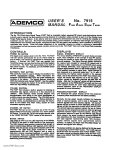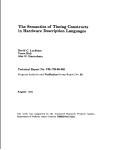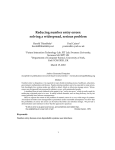Download BEYOND STRUCTURED PROGRAMMING
Transcript
BEYOND STRUCTURED
PROGRAMMING
Abstract
In abstract algebra[l], logic[8], database the0ry[16] and
other fields, normal forms are widely used to settle issues
of structure, to define ideals of form and to provide
efficiencies and eeonomies of expression. In contrast, in
computing, there has been little interest in employing
normal forms. The tremendous advantages that have been
gained from using normal forms in related fields suggests
that it might be well worth our while to try to develop a
normal form theory for program structures. Existing
structuring proposals have not done enough to control
complexity and improve the reliability and overall quality
of software.
Structured programming
principles
are not strong
enough to control complexity
and guarantee
high
reliability
of sofovare at the module level. Stronger
organizing
principles
and stronger properties
of
components are needed to make m“gniflcant ga”ns in
the quality of sofnvare. Practical proposals, based on
the definition
of normal
forms
which
have a
mathematicalllogical
foundation,
are suggested as a
vehicle for constructing sof~are that is both simpler
and of higher quality with regard to clearly dejined and
just#iable criteria.
The fact that program structures can be modelled using
graph theQry and that the semantics of program statements
may be modelled as predicate transformers [2,4,13]
provides an excellent opportunity to search for normal
forms that may capture ideals of form and composition
that can point the way to the construction of software that
is simpler, more reliable, more efficient and easier to
maintain. We will also show that such techniques offer an
excellent opportunity to put measurement of the relative
quality of software and its complexity on a much sounder
mathematical footing.
S. Pan, R.G. Dromey,
Software Quality hlStitUtC,
Griffith
University,
Nathan, Qld,
AUSTRALIA
4111
In putting forward proposals for the use of normal forms in
programming we are not interested in projecting the theory
of program structure into an obscure realm of abstract
mathematics. What we are interested in doing is providing
sound, mathematically grounded, practical principles that
can be routinely used by software engineers to guide the
construction, and measurement of key properties of
software that impact its quality. These principles define
ideals of form according to clearly enunciated criteria and
therefore also open up the possibility of re-engineering
poor quality software to a normal form. What we will put
forward here is one set of proposals for normal forms.
There may certainly be other alternatives. It is our hope
that the present work will encourage others to look at the
structure of software from this perspective.
1. Introduction
Stronger principles of programming at the module level
are needed if we are to make significant gains in
controlling the complexity of software, improving its
reliability and its overall quality. Structured programming
[3], modularization techniques and information hiding [15]
and abstract data types [9] have all made important
contributions to this end. However when we ask things
like
.
What belongs and what does not belong in a loop
body,
.
Is there an implementation for this algorithm that
has a smaller McCabe Number
●
What is the ideal structure for a sequence of
statements,
●
How many local variables
implement this algorithm, or
●
Is a given module cohesive or should it be split
into two or more smaller modules.
are needed
2. Normal
Proceedings of ICSE-18
IEEE
and
Program
Structure
In applying the concept of normal forms to program
structure there are three possible avenues of exploration
that we can pursue. We can start by looking at possible
normal forms for simple and composite statements and
statement components. This avenue also takes into
account a number of issues of composition. Another
There have been
fruitiul place to look is at modules.
proposals by Myers and others, relating to coupling and
cohesion [12]. These proposals, like the present work,
could be interpreted as suggestions for normal forms. It is
however possible to extend these proposals by taking a
more rigorous look at module cohesion and the use of
variables within modules.
to
we find there are few systematic guiding principles that
help us to satisfactorily respond to such questions. Clearly
it is desirable to have sound and reasoned answers to
questions of this sort. It is necessary to turn to other
related disciplines to find the clues that will help us
respond to such questions.
0270-5257/96 $5.0001996
Forms
The application of normal forms corresponds to the
imposition
of more stringent logical and structural
268
3. Normal
constraints on software components. In one sense, we are
suggesting that more order should be imposed on program
structures. Our intent here is to rigorously define a set of
normal forms for program structures. Before presenting our
suggestions let us f~st look at the most well-known form
associated with program structure - the proposals for
structured programming which constitute a normal form.
They require that every type of executable statement has a
single
point of entry and exit. Imposition of this
constraint has made an important
contribution
to
simplifying
the structure of imperative
programs.
Languages like Modula-2 have chosen to use a language
architecture
that directly implements and enforces
structured programming.
It is possible to define normal forms for each type of
statemeng both simple and compound that we encounter in
conventional imperative programming. These normal
forms express an ideal for representing the given statement
with respect to well-defined and testable critexia. They am
designed to achieve four outcomeK
independent
.
programming
the only normal form relevant and applicable to program
We contend that this is not the case. That, in
structure?
fact, there are a number of compatible normal forms
relevant to program structure which can be superimposed
to yield further important refinements for improving the
structural quality of programs. The suggestions we will
make are intended to simplify program structure and at the
same time make the software more reliable.
minimize its complexity,
●
maximize its efficiency, and
●
maximize analyzability.
An additional requirement is that it should be possible to
automate the process of transforming a statement into its
normal form. We will now examine the normal forms for
several key program components to illustrate the method.
3.1 Assignments
A significant contribution to program structure is made by
the statements that change the flow of controt the iterative
structures and the selection statements. It is the nested
composition of such structures which significantly adds to
the complexity of programs. What we are interested in is a
normal form that provides strict guidelines for controlling
the complexity of such structures. Single point of entry
and exit is not strong enough to prevent such structures
from becoming rather complex. At first sight it would
seem that there is not much we can do to reduce the
complexity of such structures. Proposals to date have
concentrated only on normal forms that exploit syntax and,
as such, are not strong enough to control complexity. The
key lies in proposing normal forms that exploit semantics.
Semantics allows us to impose more stringent constraints
on structures, to define forms that are ideal with respect to
some clearly specified criterion and identify semanticspreserving transformations to convert delinquent structures
to normal forms. The resulting normal form, in each case,
is not usually a property of a statement per se, but of a
statement in a specific semantic contexL
Assignments
are the simplest building
blocks of
imperative programs. An obvious syntactic requirement for
an assignment is that all variables used in its expression
should be initialized and there should be no side-effects in
the expression. Apart from these requirements there is only
one semantic obligation on an assignment. It is that
assignments should always advance a computation. By this
we require that the postcondition
established by an
assignment should not be equivalent to its precondhion.
This constitutes
a normalization
condition
for
assignments. If an assignment does not satisfy this
requirement it is redundant and maybe removed from the
computation without consequence. We may express this
normalization
condition
formally
using strongest
postconditions.
We define sp(P,S) to represent the
strongest postcondition [2,13] established by the statement
S when it executes in the context of the precondition P.
For art assignment S executing in the context of the
precondition P we require
I
In seeking to define normal forms we will use constructive
definitions. Using this approach to assesswhether a given
structure is in its normal form it is necessary to carry out a
two-step process
NAS=l:
+sp(P,S)
= P)
I
to be satisfied for the assignment to be normalized.
Otherwise such an assignment S must be a selfassignment, e.g. x:=x or establish an alreafiy-established
condition.
It is straightforward
to do a strongest
postcondition
calculation
to determine whether an
assignment is normalized.
first we transform the [branched] statement
(simple or compound) to its base form, and then
●
ensure the inherent consistency and probJemof the statement is
correctness
ma
●
An obvious question to ask is: is structured
9
Forms for Statements
we perform a semantic analysis to determine
whether the structure is already normalized
269
3.2 If-Statements
postcondition Di that is equivalent to the precondition P
for the if-statement. A normalized if-statement should
contain no nxiundant branches.
It is important to apply semantic normalization techniques
to branch statements to avoid all the potential insecurities
and correcmess problems with such statements. To ensure
that a branch structure is normalized three types of
condition must be considered the precondition P, the set of
branch guards { Cl, C2, . . .. CN ) artd the set of conditions
{ Dl, D2, . . . . DN ) that apply after each branch has
executed. Here we consider branch statements of the form
NMB-4
A significant insecurity in if-statements in most languages
is that they do not enforce the requirement that a variable
which is unassigned in the precondition P, and is assigned
in at least one branch of the if-statement it must be
assigned in every branch of the if-statement. If this
requirement is not fulfilled it leaves open the possibility
that on termination
of the if-statement
in some
circumstances the variable will be undefined while in other
cases it will be defined. This represents a correctness
problem with the if statement. The normalization
requirement is designed to avoid this problem.
[4]:
(P]
ifCl
[]
+ S1
{Dl]
C2+ S2
(>)
[1 ... + ...
OCN+SN
{ml
NMB-5
While the fwst normalization condition NMB-l guarantees
that at least one branch is reachable under the deterministi~
precondition P it does not however guarantee that all
branches are reachable under P. The normalization
condition NMB-5 requires that all branches are reachable
under the precondition P.
fi
For such a statement to be normalized we suggest that the
following conditions must be satisfied in concert.
NMB-1.
p~clVc2v...vcN
NMB-2.
Vikfj
NMB-3.
Vi (ie[l~
NMB-4.
A variable unassigned in P that is
assigned in at least one branch must
be assigned in all branches.
NMB-5.
~3i
((i,j~
-di
A
j#i)
+
(Ci =
TCj))
~ (P~Di))
((ie [l,NJ)
A 13i
NMB-6.
[l,Nl
NMB-6
To be normalized an overall branch structure must not
establish a strongest postcondition that is equivalent to the
strongest postcondhion established by one, or a strict
subset, of its branches or by a simpler statement S that
involves no branches.
((i~ [lx])
(Sp(PAC1,
P *
To illustrate NMB-6, let us consider Manna’s Abstract
Program AP [10] under the precondition true:
Ci)
P -
-Ci)
if p(y) + X=Y, do -p(x)
S1) v . . . v sp(pACN,
SN))
u -p(y)
= SAP, Si))
NMB-7.
Sp(PAC1,
S 1) v . . . v sp(pACN,
~
+
P(X)
+
SN)
/*
-P(X)
~ p(x) +
x=%
do
) */
X:=f(x)
+
[1 -p(x) + X:=f(x);
NMB-1
The first normalization condition ensures that the instatement is able to accommodate all possible initial states
under which it is required to execute. That is, there will be
no initial state defined by P for which all branch guards are
false.
od
x=f(x)
(mp(y)AX=iiAp(X)
dO
is conjunctive
+
x=~
od
/*(Yp(y)Ax=f(a)A7p(a)
}*/
r’ (-p(y)Ax=aA1p(a)Ap(f(a))
-P(X)
x:=f(x)
+
1*/
od
fi
f i f i
The last branch statement &p(x)
+ X:=X do -p(x) +
x:=f(x) od jl, after execution of its internal statement
under the precondition
=p(y)Ax=f(a)Amp(a),
yields
lp(y)Ax=f(a)A
-p(a)
A=p(f(a))
for skip
and
~p(y)Ax=~lp(a)Ap(f(a))
for *e execution of the 100P do
NMB-2
For reasons of efficiency and consistency it is desirable that
,for any given precondition, the guard for only one branch
should be satisfied. What thk means in formal terms is
that for all branch guards, the satisfaction of any guard
means that all other branch guards are not satisfied. The
second normalization
condition NMB-2 captures this
requirement
7P(x)
+
x:=f(x)
od because after the first
loop guard -p(x) fails. Therefore
sp(Tp(y)Ax=f(a)A1p(
if p(x) +
a),
X:=W do -p(x)
+
= (-lp(y)Ax=f(a)AW(a)A-p(f(a)))
v
NMB-3
A non-empty branch statement Ci + Si { Di ) in an instatement is redundant when that statement establishes a
(lp(y)AX=ilA
lp(a)Ap(f(a)))
= =P(Y)Ax=f(@A~P(@
= sp(lp(y)Ax=f(a)A1p(a),
270
0)
x=f(x)
od fi)
iteration
the
According to the condition NMB-6 the branch statement
can be replaced by the empty statement O. More generally
a normalized
branch statement should satisfy the
requirement that there exists no simpler statement S than
the branch statement such that
From a programming viewpoint, when the flag is needed
in the preceding program, the predicate x= 1 m~aybe used to
replace it. In contra%
if A[i+l]<A[p]
3W [l,i]Vte
sp(PAC1, S1) v sp(pAC2, 52) V... V sp(pAcN,
SN)) SSP(p, $
NMB-7
The normalization conditions NMB 1-6 define a number of
requirements for a normalized branch statement. The
normalization
condition NMB-7 differs
from these
requirements in that it requires that a branch statement
This condition
maybe
should have a unifkd functionality.
expressed by requiring that the postcondition should be
equivalent to a conjunctive condition if the precondition is
conjunctive.
((x=OAy=M)
programmers
v (x#OAy=M-1))
form
without
cannot
any
be simplified
disjunctive
use this sort of device
term.
branch
to set another
[] A[i+l]>A[p]
+
i,p:=i+l,i+l
fi
[l,p-l]VsG
if A[i+l]SA[p]
-)
[p+l,i]
i:=i+l
A[t]cA[p]AA[s]S,A~]
[p+l,i]A[t]<A[p]
[] A[i+l]>A[p]
[l,p-l]VsE
[p+l,i]A[t]<A[p]
because
AA[s]SA[p],
+
i,p: =i+l ,i+l Y)
AA[s]<A[p])
v
(Vte [l,i-l]A[t]<A[i]Ap=i)
[l,p-l]Vse
the latter implies
[p+l,i]A[t]<A[p]AA[s]SA[p]
(as
the former)
3.3 Loops
The use of semantics allows us to clearly and precisely
define a number of important structural ancl correctness
requirements for loops. We will divide our discussion of
the normalization requirements into two parts,, the first part
consists of requirements that apply to all loops and the
second consists of those requirements that apply to loops
that contain branched loop bodies, i.e., they contain IFstatements and/or loops). In our discussion we will
consider a geneml loop do G + S od that executes under a
precondition P. These requirements extencl beyond the
usual requirements for loop corred.ness [4].
to a
Often
variable
test in the
3.3.1
Basic
Normalization
Conditions
for
Loops The general requirements are designed to ensure
that the context defined by the precondition P and the guard
G, really warrants the use of a loop that has the potential
to execute more than once and to terminate.
The
precondition P here is not the loop invariant but rather a
condition (established by the loop initialization) which
will always strz”ctly imply the strongest loop invariant for
the loop.
When the disjunctive postcondition
D1 v D2 can be
simplified into an equivalent conjunctive form D, there are
two cases that apply. One is that the weakest branch
postcondition
Di is equivalent to D, and another Dj
ituplies D (as D1 v D2 = D v Dj = D, where j= [1,21).
Another case is that both of the branch postconditions D1
and D2 imply D, and each of them has an extra part Ri,
i.e., Di = D A Ri. for i= [1,2], which satisfies R1 v R2 =
true. We suggest that the normalized branch statement
should be classified according to the fmt case, rather than
the second case. Because, from a theoretical viewpoint,
these Ri do not appear in the postcondition, they maybe
used only for branching purposes (otherwise they are
redundant).
From a technical
view point,
if these Ri are
LBN-1
The fwst normalization condition LBN- 1 requires that the
loop is reachable for all possible initial states under which
it must execute. That is, there must be nc~initial state
defined by a non-grounded precondition P for which the
loop guard is false.
needed for the branch statement as branch conditions, the
branch conditions or their modifications of the original
branch statement that produces these Ri may replace them.
For example, ~ x=O + x:=1; flag: =true [] x#O -+
x:=x+ 1; flag: =false fi is not a normalized branch
statement under any precondition P(x) because
sp(.p(x), ~x=O + x=1; flag=true
[] x74+
x:=x+1; flag=falsefl)
V X-h@A+kt@
= p(X-l)A(X=lAfktg
= p(X-l)A((X=l)++fk@A(X=lV
= p(X-l)A((X=l)++f@)
[l,p-l]VsE
= ~pe [l,i]Vt~
statements
that follow. However we may use x=O and x#O to replace
this additional test. This is possible because in one sense
this branch statement establishes another flag, y, from the
original flag x.
y that can be used in another
i:=i+l
sp(3pE [l,i]Vtc
= (3pE [l,i]Vtc
To understand this, consider a two-branch statement {
a(x) Ab(z) ] ~x=O + y:=M [] x#O + y:= M-l~i
as an
example. Obviously,
the postcondition
a(x) Ab(z) A
conjunctive
+
is a normalized branch statement under the precondition
LBN-2
The condition LBN-2 deals with the efficiency of a loop. It
is different to LBN- 1 in that the loop m;ay execute a
number of times, however it demands tlhat the loop
x#l)
establishes more than simply the negation of the loop
guard without changing the precondition
P. For example,
the loop { P ) do i#N + i:=i+l od should be avoided
From a logical viewpoint, the flag is equivalent to the
predicate x=1, which means there is redundancy present.
271
be reached. Also if either of these conditions implies the
negation of a branch condition, then that branch is
unreachable. A normalized, branched loop body avoids all
of these problems. What LBB-2a,2b tell us is that each
branched loop should have a strongly connected branch
successor graph. For example, the following List Merge
[11]
because it produces only the condition i=N even though it
may execute a number of times.
LBN-3
Any loop, to be deserving of that status should have the
potential to execute more than once for a given nongrounded precondition P and guard G. This requires not
only that the loop is reachable, but also that it is
executable at least twice. What this means in formal terms
is that the postcondition from the fiist iteration should not
imply the negation of the loop guard.
OUC=NII;
do (ii1#N11)v(in2#N11)
+
~ (in2=Nil)v((inl#Nil)A(in2#Nil)@il
+
LBN-4
Every mop executing unaer us strongest mop ntvartant 1
should have a structure which guarantees, that when the
loop body executes it does not establish a condition which
implies the loop guard G. Obviously, if it does, the loop
is non-terminating.
out:=out+inl
.hea~
.headSirt2.head))
inl=inl
tail
[1 (in2#Nil)A((inl=Nil)v(in2=Nil)v(inl
+
ouc=out++in2.head,
.head2in2.hesct))
in2=in2.tail
fi
od
contains
four branches
Z&in2=Nil
LooPs
3.3.2 Loops
with
Branched
Bodies:
structures that contain branched bodies are often regarded as
the most complex, the most difficult to analyze, and the
most likely to contain logical flaws. It is therefore
important to see how the concept of normalization may be
employed to make such structures more tractable.
+
within
its loop body
oub=out++irtl
[] (in2#Nll)A(in1
=Nil)
+
head;
inl :=inl
tail
ou~=out++in2.hea~
o (in2#Nil)@l#~ll)A(k1.he
ad<in2.hesd)
out:=out++inl
o (in2#Nil)@t~#Nil)A(in~
.hea~
in2:=in2.tail
+
inl :=inl
.head>in2.head))
ouc=out++in2.head,
tail
-+
in2:=in2.tsil
fi
It satisfies the conditions LBB- la and LBB-lb, however it
fails to match LBB-2a and LBB-2b because after execution
of the f~st or second branch, the control-flow will remain
in the same branch or terminate. Also after execution of
the third branch, the control-flow will only enter either the
second or the third or the fourth branch, or terminat~ and
so on. We may use the following branch successor graph
(BSG) to illustrate this:
Any loop with a bmnched body can be transformed into the
following equivalent form (in many instances S will be
empty) [14]:
{P)
doG*
s;
lycl+sl
C2+ S2
[]
[1 ... + ...
[] CN + SN
fi
od
The basic normalization conditions for loops apply for this
loop structure. Additional normalization constraints that
apply to branch structures areas follow~
~~x~~~
,...........+...
...............................
....... .. .....................
......... .... : :
~
looD w
~~~
mmg~@M
each branch
should be reachable,
LBB-la.
-I 3i ((i~ [l,Nl)
sp(P A G, S) ~
Ci)
LBB-lb.
-3i
sp(P A G, S) s
~Ci)
After
((it
These quality defects are caused by poor decomposition of
the problem. We may remove these defects by formally
transforming this algorithm into the following equivalent
form:
[l,Nl)
each iteration
each branch
should be reachable,
LBB-2a.
~3i
Vj((i,je
[l,Nl)
SP(SP(G, S) A
LBB-2b.
~3i
Vj((i,je
[l,N])
SP(SP(G, s) A
Cj.
Cj,
Sj)
Sj)
out:=Nil;
Le.,
*
+
i.e.,
do (in~#N@A(in2#Nil)
I
if inl .head4n2.head
-)
-+ out:=out++inl
.hea~
inl=inl.tail
[] inl .head2in2.head
+
Ci)
ou~=out++in2.hea&
in2=in2.tail
fi
~ci)
Loop Prozress: each branch should decrease its variant
od;
function
do (iil#Nll)
-+
outi=out-t-t-inl
do (in2#Nil)
+
ouc=out++in2,he@
If SP(F’ A G, S) or SP(SP(G, S) A Cj, Sj) implies one of
the branch conditions, then other branch conditions cannot
.hea~
irtl=inl
.tsil o~
in2=in2.tail
od
The transformations
required to achieve this result
correspond to splitting the original BSG into its three
272
strongly connected components (corresponding to the three
loops). A more detailed treatment of loop reengineering is
given elsewhe~[14]
3.4 Non-Iterative
Sequences
Simply composing a compound statement of normalized
statements is not strong enough to guarantee that the
compound statement is in a normal form. Here we consider
non-iterative sequences that are composed of assignment
statements, input/output statements and if-statements.
There is a potential for un-normalized sequences to contain
redundant assignments, redundant tests and involve the use
of variables for more than a single purpose. All of these
defects may be removed by a sequence of transformations
that include several optimization.
We will now examine
the optimized
structures of non-iterative
statement
sequences, which contain no logical redundancy. An EBNF
definition will be given for each of these structures.
NNL!U
Bounded
<Obmos>:
We may extend any non-iterative statement sequence
consisting of assignments, I/O statements to include ifstatements. When all branch-guards of an if-statement
depend on at least one read-variable, these branch-guards
are not pre-determined
for arbitrary input. Several
transformations [13] exist which enable us tc~locate such
an if-statement in front of all statements that follow the
read-statements which initialize at least one read-variable
that appears in the branch-guards. The encapsulating
structure starts with a number of (one or more) readstatements followed by an if-structure, called the Bounded
Branch Structure. In this branched structure each internal
statement (branch body) is either another bounded branch
structure or a sequence in <Omos> or <lObmos> or
<Ob~#.
NNl&2
Bounded
Branched
Optimization
Structure
<obbo5>:
This is a redundancy-free, recursively defined wquence that
starts with a number of (one or more) read-statements
followed by a branch structure, in which each branch-guard
involves at least one read-variable
assigned by the
previous read-statements and each internal statement is a
sequence in <Omos> or <Obmos> or <Obbos>.
{; <Omos>] I write(E) {; <Omo5>)
The order of the statements in a cOmos> sequence can be
::= read(x);
‘“bbos>
freely interchanged using a straightforward
set of
substitution rules. For example, the following two threestatement
sequences establish
exactly
the same
postcondition
S:=x-y
Structure
::= read(x); <Oreo@ I read(x) (; <Obmos>),
‘%mos>
Structure <Omos~Z
PJNIS. 1 M inimum Optimization
This is a redundancy-&e sequence containing assignments
and write-statements, where any variable is assigned only
once. In EBNF we have
X:=a+b, y=u*v;
Optimization
This is a redundancy-free sequence, which starts with a
number of (one or more) read-statements followed by a
sequence in <Omos>, where each variable is assigned once
either by a read-statement or an assignment. In EBNF we
have
We start with the structurally simplest sequence. Consider
any non-iterative
statement sequence consisting of
assignments and write-statements only. We can apply
simple transformations
[13] to remove all redundant
assignments from the sequence. The resulting sequences
have the property that no variable is assigned twice. Hence
we have
<omo5>::=@I x:=E
Minimum
if Cl(x,...
) +
<Body>
[] ... [1
Cm(x,...) ~ cBody> fi
I read(x) {; <Ob~s>),
where cBodp
where
any
::= COmos>
variable
in
I -@bmos>
any
assigned only once for each execution
1= s:=a+b-u*v; x:=a+b, y:=u*v
i~ [1 ,m] must involve
all pre-tlxed
I <~~s>
<Obbos:’
ad
structure
path, and Ci(x,...
is
) for
read-variables;
We may extend the complexity of <Omos> sequences to
include any non-iterative statement sequence consisting of
assignments and 1/0 statements only. When all readstatements involve different read-variables, there exist
transformations that allow all read-statements
to be
relocated at the front of the sequence. When there exist two
read-statements involving the same read-variable,
a
reassignment mle is used to rename the first read-variable
and its usages by a fresh variable. This allows all readstatements to be placed at the front of the sequence. The
rest of the sequence contains only assignments and wn”testatements that form a <Omos> sequence. TMs leacls to a
new optimized sequence that satisfies the following
definition:
When
there exists
independent
of
transformations
an if-statement
any
exist
whose
read-variable
which
enable
branch-guards
in
the
us to loca[e
are
sequence,
thk
branch
at the front of the sequence. This constructs a
branch structure directly. In such a branch structure, each
internal statement can be simplified into a sequence in
-@bbos> or <Obmos> or ‘@mos>.
statement
Structure cO~05>:
JWIS-4 Branch Optin”zation
This is a redundancy-free branch structure such that all its
internal branch statements are sequencesin either <Ob~s>
or <Obmos> or <O~os>.
<~s>
273
::= if Cl ~ dlody>
[1 ... [1 Cm + x:Body>fi,
where arty variable in any <Ob&
removal of the expression set to which 1 corresponds.
When x:=f is in a lwp structure, not all local variables
can be removed, e.g., local variables may depend on their
value in a previous iteration. The detailed treatment of this
is given in [13].
structure is assigned
only once for each execution path;
Sequences in <obos>
and <Obbos>
have similar
properties to sequences in <Omos> and <Obmos>. Each
variable is assigned once (for each execution path) either by
a read-statement or an assignment and the order of any
read-statements that bounds a branch structure can be
fteely changed by appropriate variable substitution within
their range.
After removing
local variable assignments, either
completely or partially,
we can build a Variab /e
Depen&mcy Directed Gruph (VDDG). The formal deftition
is
Given any multiple assignment x=f, its VDDG is a
directed graph containing a node set x and an edge set
{CX,P I (x=j’)~ (x=f), ye (V(f)-(x))),
i.e., variable
x connects to all its dependent variables except itself,
where V(j’) is the variable set of f.
Strongest postcondition
calculations,
together with
transformations in line, provide a means to restructure any
non-iterative
statement sequence into an equivalent
sequence
in
optimized,
redundancy-free
<omos>l-J<Obmos>
lJ<Obbos>U<Obos>.
These fOUr
structures define the Optimized Structures for any noniterative statement sequence.
4. Variable
This graph cannot contain any self-cycles. The problem of
determining the maximum number of local variables may
be translated to determining the number of local variables
that convert a multi-assignment into an implementable
assignment sequence in an imperative program. Two cases
apply for the VDDG. They are.
Normalization
The way variables are used can have a significant impact
on the quality of software. Single assignment languages
like SISAL overcome most of these problems. Here we
will consider requirements that may be applied to
imperative programs that do not exploit single assignment.
The consistency principle tells us that a variable should
only be used for a single purpose. Local variables are
frequently used to help achieve this ideal. This does not
mean, however, that local variables should be declared
freely. For example, with the module swap(x,y), the ideal
segment should use one local variable, i.e., c=x; x:=Y,
y:=t, rather than two local variables, such as tl:=x; t2:=y
x:=t2; y:=tl. Some formality is needed to resolve this sort
of problem.
●
●
the VDDG is a tree (or a number of trees) without any
cycles
the VDDG is a tree-structure (or a number of treestructures) with cycle-nodes
When a given VDDG is a tree (or a number of trees), no
local variable is needed because we can use an extended
Pre-Order
traversal of the tree to decompose the
corresponding multi-assignment into a normal assignment
sequence. This order also defines the principle for
decomposing any directed graph with cycle-nodes. The
following diagrams illustrate these idew
Local variables are used to record state information at
critical points in a computation. It is not easy however to
determine the number of local variables for the ideal
representation of a given algorithm or program. Instead, we
may use calculations to define the maximum number of
local variables to model a particular set of state-recording
requirements for any algorithm. When a program uses
more local variables than the maximum required number,
then its local variable set should be reduced by
normalization.
Before defining the maximum number of locat variables
needed, we need to convert any assignment sequence by
substitution into an equivalent multiple assignment x=,f.
For example, with two output variables x and y, the
sequence tl :=X t2:=~ x:=t2; y:=tl produces (tl, t2, x,
Y):=(x, y, y, x). Since x:=f
may contain more local
variables than necessary, we need to remove the local
variable assignments from x:=~. Given any x:=.f and a
local variable set 1 then as long as such a multiple
assignment is not bounded by a loop structure, we can
always achieve (x-l) :=f’, where f‘ is the sub-set of f after
27’4
The three inmlementations below illustrate the imnact
of
.
applying
v~iable
normalization.
The normalized
implementation (RaGCD) uses six rather than the seven or
eight assignments used in the other two implementations.
It-Ra6CD-each variable is used only for a single purpose,
When a VDDG is a tree-structure [or a number of treestructures) with cycle-nodes then for a simple cycle that
contains no subcycle a local variable is needed to
decompose this cycle into a tree. However a more complex
prccess [13] is needed to handle a complex cycle ‘that
contains nested subcycles.
............ ....................
,.,.,.,,,,,
,,.................. ,.,. .,.,,.,.,.,.,
..::..:,:::
:::::.................:,:.:,:,,,.
..............
..........
...............
......... :,: ........
,.:.:.:.:.:...,
...
:~~*2:~.~~~~~:::::~:&Qm:wo*tisti*3&wid$:.:wfidw.Bwy2$#fi&$m#&&&&;#M&#M#=wH
...’....:.:.:
: : :.: : . . . . . . . . . . . . . .. . . .. . . . . . ., . . .
Example
rwo implementations (ExGCD1 and ExGCD2) of the extended Euclid’s GCD algorithm, have been presented lby
Iensen & Wirth[6] and Horowitz & Sahni[71 respectively
ExGCD1:
ExGCD2
RaGCD
C:=M, d=N, X*, y=l ;
C:=M, &=N, X4, y=l;
C=M, d=N, X*, y:=l;
do #O+
do d#Ct+
do #l +
q=c/& FcJ?lodCt
Prex=w pnx=q
q<ltt Rcmoiw
x:=y-c/d*x; y=prex,
y=yq*x
c=@ d=c
w=xq*~
C:d, (M
X:=y;
y=w’
CA@=pmnwdd
r=x; X=y, y=r
od;
Od,
Od,
if yKO + y:=y+p Y; return(y)
Mum(y)
return(y)
After applying equivalence transformations we get (q, r, c, d, x, y):=(c/d, x, d, cmodd, y-c/d*x, x) from the loop
body of ExGCD1. After removal of lmal variables q and r, we obtain the underlying logical intent of the body, that
is, (c, d, x, y) := (d, cmodd, y-dd’x, x). Its VDDG and normalized result RaGCD are as follows
27’5
5. Normalization
of a Program
Fragment
In this paper we have defined a set of normalization
conditions for individual statements and for composite
statements.
These normal
forms
which
have a
Taken
mathematical/logical
basis express an ideal.
together these requirements provide a basis for constructing
Such programs
what we will call well-structuredprograms.
should be composed only of normalized statements at all
levels.
We claim that programs composed only of
normalized components are far more likely to be less
complex and more reliable. To make this point let us
consider Manna’s Abstract Program AP [10] as an
example
~~P(Y) ~
x:=Y; do ~P(x)
~
x:=f(x)
od
if P(X) e do 7P(x)
n Vp(x) +
~
x:=f(x)
od
a
bcd
XY
e
z
If we denote the module input and output sets by I and O,
and we construct the VDDG graph <IuO, E>, where E
is the edge set for the module/program
then the
normalization conditions may be expressed formally as
follows
n rip(y)
+
X:=a,
2EE!Z-I
X:=f(x);
if p(x) +
x:=3 do 1p(x)
+
x:=f(x)
odfi
-A <x,y>= E(xe I’Ayc O-O’ v xc I-I’Aye O’))
fi
fi
These two normalization criteria provide a very effective
means for deciding what functionality
belongs in a
particular module. In the noncohesive module above the
component with output z and dependent inputs d and e
should be in a separate module.
When this program fragment is normalized (and hence reengineered) we get the following equivalent much simpler
and non-redundant program tiagmenc
if P(y) +
[1 ~p(y)
x:=y
~
~ p(a) j
x:=a [] =p(a)
s
x:=f(a)
7.
fi
Conclusions
fi
6. Module
Structured programming, information hiding and ADTs
have made important conrnbutions to program quality.
However such techniques alone are often not strong
enough to control (reduce) complexity to manageable
levels, make software more reliable and make it easier to
understand and change. The weakness of these methods
when they are applied to structures is that they do not
effectively take into account contextual and semantic
issues. As a result, they do not guarantee that complexity
will be limited and that high quality software will always
be produced by following their guidelines,
Normalization
Cohesion is usually cited as the criterion that maybe used
to decide what belongs in a given module and what should
be implemented elsewhere(12]. Unfortunately this concept
is rarely defined precisely enough to be used a basis for
module normalization[5]. Two formal requirements must
be satisfied for the functionality encapsulated in a module
to be cohesive. These requirements maybe formulated in
terms of input/output
dependencies.
Where mutual
dependencies exist there is cohesion. Assessment of a
module’s cohesion is easiest to make using a graphtheomtic interpretation. The two normalization conditions
are as follows:
What we have suggested in the present discussion is that
there exists, beyond structured programming, another level
of structuring, based on context and semantics. This level
is more subtle, but it is significant in its impact on the
quatity of software.
MVN-1
Each output variable must depend upon at least one input,
and each input variable must be used to produce at least
one output variable.
[n the past decades, much of the mathematics/formal
methods that have been brought to bear on programs has
looked only at the semantics/correctness of components.
of
What we need to invent is the mathematicstlogic
MVN-2
The input/output variable dependencies must be represented
connected bipartite
graph.
The 1/0
by a single
dependencies in the diagram below violate this criterion.
structure
for
uncomposed).
program
components
(composed
and
Normalization
of simple and complex
statements, of variable-usage and of modules provides a
vehicle for achieving these goals. To realize the normal
276
forms we have described we have three choices get the
programming language to enforce them, leave it to users
to design components that conform to the normal form
requirements, or develop tools that can automatically reengineer un-normalized components to their corresponding
normal forms. Obviously the fwst choice is the best. It
does however require some refinements to existing
languages and compilers.
References
1.
2.
3.
4.
5.
6.
7.
8.
9.
Birkhoff,
1967.
Dijkstr%
G., MacLane,
S., Algebra,
MacMillan,
N.Y.
E.W., Scholten, C.S.: Predicate Calculus and
1989.
Program Semantics, Springer-Verlag,
Dahl, O.-J.,D@str& E.W. and Hoare, C.A.R., Structured
Programming, Academic Press, N.Y., 1972
Dromey, R.G., Program Derivation, Ad&on-Wesley
Press, 1989.
Dromey, R.G., Cornering theChimera, IEEE Software
Jan., 1996.
Horowitz,
E., SaI@ S., Fundamentals of Computer
Algorithms,
Computer Science Press Jnc., 1978
Jense~ K., Wirth, N., PASCAL
User Manual and Repoz
2nd cd., Spring-Verlag,1974.
Kleene, S.C., Mathematical Logic, Wiley, N.Y., 1967.
Lkkov, B.H., Zilles, S.N., Programming with Abstract
Data Types, SIGPLAN Notices, 9(4), 50-59, Apr. 1974.
10. Mann%Z., Properties of Programs ond the First-Order
Predicate Calculation, JACM 16(2), 1969.
11.
12.
13.
14.
15.
16.
McDermid,
J.A., Software Engineer’s Reference Book,
Butterworth-Heinemann,
1991.
Myers, G., Sojiware Reliability: Principles and Practices,
Wiley, NY (1976)
Quality Improvement, Specification
Pa S., So~are
Derivation
and Measurement
Using Formal Methods, PhD
Thesis, Griffith
Uni., Australia.
1995.
Pan, S., Dromey, R.G., Re-engineering
Loops, Computer
Journal (accepted for pub.)
Parnas, D. L., On theCriteria to be Used in Decomposing
Systems into Modules,
Comm. ACM., 5(12) 1053-1058,
Dec. 1972.
of Database and KnowledgeUlhnan, J.D., Principles
Base Systems, Computer Science Press, 1988.
277































